Barcodes come in many flavors that can serve different purposes. A key to using them is also having the appropriate scanner to read the barcodes that you work with daily. Also, thinking proactively when it comes to barcode scanners. Just because you do not use that type of scanner today, is there a chance you may in the future? Would it be a good business decision to invest in a more advanced scanner now or wait until you reach that point in your business plan.
Before you can decide on which scanner best meets your needs, you need a good foundation on the different barcode types. I like to call it Barcodes 101!
Barcodes fall into two main categories, one-dimensional (1D) and two-dimensional (2D). One-dimensional represent data through the widths and spacing of parallel lines and include: UPC, EAN, Code 39, CODE 93, GS1 Data Coupon, and ISBN barcodes. Two-dimensional barcodes represent data through two-dimensional shapes and symbols and can represent more data than one-dimensional barcodes. QR codes and PDF417 are a couple of examples.
One-Dimensional Barcode (1D)
UPC Codes
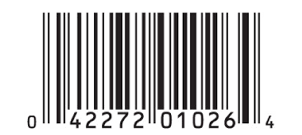
The most recognizable barcode type is the UPC, Universal Product Code. It is most commonly used in the retail industry. Although it is mainly used in the United States it is also used throughout the world, including: Canada, England, Australia, New Zealand, and Europe. Each number or line represents something to help determine a specific item that is linked to the UPC code. There are two types of UPC codes, UPC-A with 12 numeric digits and UPC-E the suppresses zeros in the UPC which leads to the length varying between 6-12 digits.
EAN Code
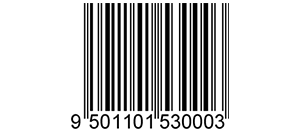
EAN code (European Articles Numbers) is a 12 or 13-digit number uniquely identifies a product, manufacturer, and its attributes. The EAN is very similar to the UPC except for the country code identifier in the written numbers, but the lines and width are the same. There are two different types of EAN barcodes EAN-13 and EAN-8.
Code 39
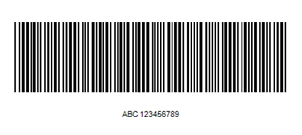
Code 39 is widely used in the automotive industry, the department of defense, and name badges. It is variable in length. Code 39 symbology represents numbers 0-9, upper-case letters A-Z, the space character, and symbols – . $ + %.
Code 93
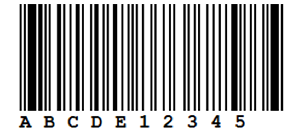
CODE 93 is alphanumeric numeric code that was designed to enhance Code 39. Code 93 offers a more secure continuous symbiology to provide a more secure coding. The symbology can encode 47 different characters, including: uppercase A-Z; the digits 0-9; the space character, symbols – . $ + % /, and special characters, including the start/stop symbol. It is used for name badges, inventory, and industry, but most commonly used by the Canadian Post Office.
GS1 DataBar Coupon Format
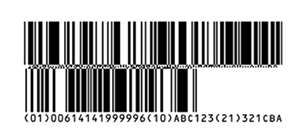
GS1 DataBar was formally know at RSS or Reduced Space Symbology. It was developed to help provide a more concise barcode and has been widely accepted on coupons. The coupon value can be any amount up to $999.99 and can add a more precise description to account for quantity. It has hidden data to help with fraud prevention and automated expiration data.
ISBN Barcode/EAN 5
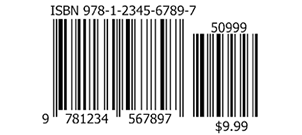
ISBN (International Standard Book Number) uniquely identifies a commercial book or book like product such as an audiobook or card. The ISBN ranges from 10-13 digits and often is combined with EAN 5 to show the price of the book.
Two-Dimensional Barcode (2D)
QR Codes
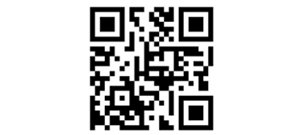
QR Code (Quick Response) are the most recognizable of the 2D barcodes and can contain more than just a symbolic representation of an item, but can also include tracking or marketing information. They can contain 100 times more data than the 1D codes, but they can also be scanned digitally. Although you may see the QR code on an advertisement or business card, more common retail application is for entertainment and transporting ticketing. They are free to use, flexible in size and easily read.
PDF417
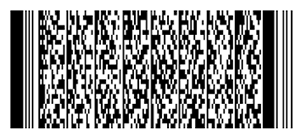
PDF417 are free public domain 2D codes that contain large amounts of data and have a variety of applications including identification cards, transportation, logistics (FedEX). Large amount of data can be stored securely and inexpensively. The symbology consists of several linear rows of stacked codewords representing 1 of 929 possible values in clusters.
Choosing The Right Barcode Scanner
QR Code (Quick Response) are the most recognizable of the 2D barcodes and can contain more than just a symbolic representation of an item, but can also include tracking or marketing information. They can contain 100 times more data than the 1D codes, but they can also be scanned digitally. Although you may see the QR code on an advertisement or business card, more common retail application is for entertainment and transporting ticketing. They are free to use, flexible in size and easily read.
Scanner Categories
Laser Scanners
Laser scanners are the most common and uses a red laser to read the reflectance of the black and white spaces in a barcode. Once the barcode is read, the decoder interprets the barcode using the check digit and converts it into text. It only reads 1D barcodes but is often the most cost-effective option. They can easily be programed using a scanner set up sheet to the tell a POS system how to interpret the code in relation to the data on file.
Linear Image Scanners
Linear Image scanners are like laser scanners but instead of reading the barcode, it takes a picture of the image and interprets it. They are more effective at reading poorly printed or damage codes. For businesses who deal with printed barcodes or deal with damaged or hard to read barcodes, linear imagers are a better option.
Omni-Directional Scanners
Omni-Direction Scanners read 1D images like laser scanners, but have additional mirrors to transform the laser line into many multi-directional lasers to make it easier to read barcodes. It is best suited for high volume POS situation, like super markets.
2D Area Scanners
2D area scanners can read any type of barcode, 1D barcodes or 2D barcodes. The 2D scanner is more intelligent that other scanners because it can read the barcode no matter what the orientation is, and off varied surfaces such as phone screens.
Scanner Categories
Most people are familiar with the gun-style scanner, but scanners fall into 4 main categories for retail: handheld, presentation scanners, mobile computing and in-counter. Each option meets different business needs and selecting the correct scanner will save you money and make you more effective.
Handheld
The most prevalent category is the handheld or gun style barcode scanner. Handheld scanners are the most popular, because they are easy to operate and are cost effect. Don’t let handheld fool you, even though they are called handheld; many come equipped with stands for hands-free use.
They come in both corded and wireless. While the corded scanners are less expensive; the mobility is limited to the length of the cord. Corded scanners are historically more durable, powerful, and reliable. They are a great option if you are using them in a stationary location.
Wireless handheld scanners give you more flexibility when scanning barcodes. The scanner communicates with the base, which transmits the information back to the POS workstation. Although it is mobile you must stay within the range of your base for it to be functional, but some top-end wireless handheld scanners have a range up to 50 feet!
Presentation Scanner (Counter-Top)
Presentation Scanners are stationary, and the items are passed in front of the scanner allowing for hands-free scanning. They are omni-directional and allow for a faster and easier reading, with a less precise scan. In the market today are presentation scanners that can read 1D and 2D barcodes. They are ideal for retailers who need a cost effective and reliable solution. Another advantage is that they can read 2D barcodes on mobile device screens, for electronic coupons, tickets, or boarding passes.
Mobile Computing
Mobile computing takes scanners to the next level because they not only scan the items, but they also connect back to the main database for sales transactions or inventory management. The mobile computing option gives you more freedom because the PC and scanner is integrated and goes with you; unlike other categories that either are attached or must be in range of a POS workstation. Mobile computing scanners are often made more durable because, they are designed to move around which can increase the risk of dropping the device. They are more expensive than their counterpart, because they combine both the computer and the scanner in one device.
In-Counter
These scanners are made to be mounted in the countertop and well suited for high-volume retail situations. To scan an item, you simply place the barcode face down on the scanner versus passing it in front of the omni-directional laser scanner. They provide a clutter-free workspace and boast a faster read rate than their counterparts. You also have the option of having an integrated scale, which makes them an ideal for grocers and other retailers that sell weighed items.
Understanding your options is critical in the retail industry. With technology constantly evolving, it is important to keep up with the products that will help save you time and drive more revenue. As always, take your time, know what your goals and select the right product to help you meet those goals.






